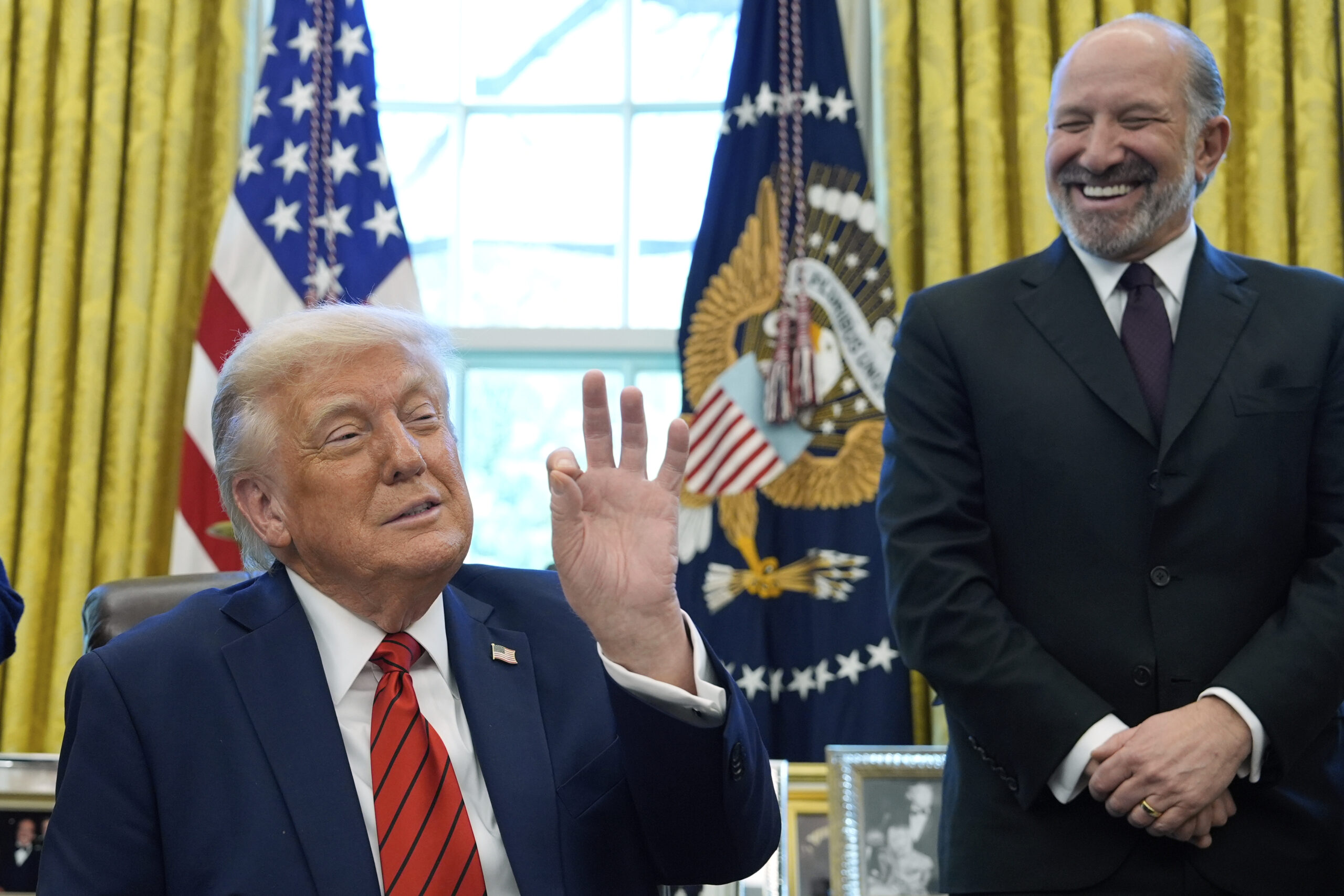President Donald Trump is carving out his own brand of capitalism — launching extraordinary federal interventions in the economy through ownership stakes in private companies alongside sweeping tariffs, tax cuts and deregulation. But the way he’s using these tools isn’t really guided by a discernable economic strategy, according to one of the world’s experts on industrial policy.
Mariana Mazzucato, an economist who has advised governments around the globe, said Trump’s policies, taken together, are more like “an idiosyncratic hodgepodge.”
“Trump is not asking, ‘What are the problems that need to be solved, and how can we have public investment to solve those problems?’” she said in an interview with POLITICO Magazine. “He’s just kind of throwing money around and imposing tariffs and taking these equity stakes and dismantling things.”
It’s a notable critique because Mazzucato, who runs the Institute for Innovation and Public Purpose at University College London, is exactly the kind of person who might support Trump’s efforts to reshape certain industries. She has made the case for years that politicians should take steps, like buying equity in private sector firms that receive government support, to help citizens share in the benefits of public investment.
But she said the government also must have a clear vision for what it wants as it tries to work with the private sector to build a prosperous society — something, she argued, the U.S. did very effectively in fostering the conditions that led to the birth of Silicon Valley.
“It doesn’t mean you want a big state or a small state,” she said. “You want a smart, capable state.”
This interview has been edited for length and clarity.
President Trump has started taking minority government stakes in some private companies. Why do you think he’s doing that?
In general, the whole point of taking equity stakes is if you think the stake itself led to the evolution of a company, a technology, a medicine.
One way to socialize the risks and the rewards is through equity stakes. But that only makes sense as part of an industrial strategy.
He’s taking, for example, 10 percent equity in Intel and so on. But he’s just taking a clawback measure without it being linked to the creation of value. So it’s just taking, not making.
I think he’s doing it to show strength. He puts up walls, he uses tariffs, he wants this all to make him look mighty and strong while he’s actually weakening the economy by eliminating the very industrial strategy that led, in the past 50 to 100 years, companies like Intel to be born.
Do you think that what he’s doing qualifies as industrial policy?
Industrial policy is a portfolio of different measures. Any measure, say, a subsidy, on its own is not industrial policy. As I define it — this is not nuclear physics, it’s economics, so people might disagree — but in my view, industrial policy is not one tool. Subsidies alone are not necessarily good policy. Subsidies as part of a holistic approach to, for example, the green transition, or if one wants to be the top of the world around artificial intelligence or back in the day, the whole [information and communication technology] revolution, that could be part of the strategy.
So, I don’t think what he’s doing, looked at in a singular way, is either right or wrong. But what he’s doing, with the absence of a holistic — meaning a whole set — of other measures, it’s not industrial strategy. It’s just literally a clawback.
You were talking about how it’s useful to tie these policies to actual outcomes. So is the issue more that the industries where he’s taking a stake are not necessarily ripe for the kind of industrial policy that works, or is it that he’s not being specific about what he wants from those companies?
It’s a bunch of things — you outlined a big chunk of it. In my view, industrial policy done right is with a direction. And forget good or bad direction. Any direction.
If you want to actually direct the economy, that’s already kind of heterodox, right? Because usually standard theory is that the market directs the economy and the state should just pick up the pieces: The private sector and the financial sector decide, based on incentives and pricing, what to do. And if that ends up creating problems in the economy, like that means we end up without enough basic research, or that means we end up with unclean water, the state is supposed to come in and fill the gap and fix the market failure.
Where industrial strategy comes in is you say, “Actually no, according to history, the evolution of industries themselves have required all sorts of — you could call it, a visible hand, not an invisible hand.”
When I wrote The Entrepreneurial State back in 2013, it was to debunk the myth that Silicon Valley itself had come about through the private sector. The measures that I unpacked in detail in the book were both supply-side measures like enormous amounts of loans and subsidies but also demand-side, pull measures like procurement policies, the [Small Business Innovation Research] tool, which said every government department has to spend about 5 percent of their procurement budget on innovations by small and medium enterprises. That’s historically been exactly the kind of measure that allowed companies like Intel to be able to grow, to scale.
The reason that you have a bunch of startups in Europe that don’t scale is that there hasn’t been that strong kind of demand-pull, market-creating types of policies like the U.S. military-industrial complex has provided for U.S. companies.
All the technology that makes our smartphones smart and not stupid would never have happened without the state taking an active part of shaping investments. The internet, DARPA, GPS, the Navy, touchscreen display, Siri. They’re all out of public investments.
And these were also investments that came out of problems that had to be solved.
You were talking about how investments are useful in terms of helping new companies grow. Is part of the issue that the U.S. is taking sort of the state champion approach, rather than trying to foster a more dynamic, innovative marketplace?
He’s not doing anything to create those state champions. You’d be talking about the kinds of investments that got us Boeing, or that got us Embraer in Brazil.
Not only is he not doing what you just said, he doesn’t have that holistic set of policies that would allow new entrants and allow them to scale. Don’t forget, the point is not just to have new entrants. You want them to then have a market to serve, otherwise they just go bankrupt.
A lot of these companies that he’s thinking about taking equity stakes in are not the fruit of any sort of investment that he has been part of. So, it’s kind of retroactive.
Any smart industrial strategy will make sure that the existing large companies are part of a transformational agenda, right? Like, in Germany, the steel sector. They actually had a particular agenda around carbon emissions.
That’s the only reason there’s green steel in Germany, because it was a conditional loan that required that sector to basically innovate with that direction.
Forget if it’s a green direction, a blue direction, a pink direction, a purple direction. The point is the government had the confidence to make sure that that public loan was conditional, that the private sector actually innovate. And that type of conditionality, if it’s linked to innovation, can also make sure that your large companies, that those national champions, also stay ahead of the curve. Because we don’t want these large companies just to become lazy and uncompetitive.
The government does have this stake in Intel. So isn’t it possible that they could exert influence over Intel’s behavior and try to say, “These are the kinds of things that we want to see from you?”
Absolutely, or, the investments they’re taking in MP Materials or the golden share in U.S. Steel and so on.
The question is, what happens to the equity stake? Does it go into a U.S. innovation fund to help that next wave of tiny Intels grow into big Intels? Or is it just going back into some pot of money that he’s giving out in a random, idiosyncratic way?
Now, in terms of conditions, the equity stake itself is a material condition, which is that you’re taking a share of the pie to not just go to the private sector.
The question is, what is the narrative through which you’re taking that stake? And I think what’s important is, if you actually have that holistic set of policies, then equity stakes become important because they become part of the narrative of the state itself as a value creator, as opposed to just a redistributor, an administrator, a facilitator, an enabler, a fixer. And if you want an active, proactive state that shows the muscle that he’s trying to show, what you want is also to accompany that with that narrative.
Instead, he’s doing the opposite. He’s constantly blaming the government. He also introduced DOGE, which was also very idiosyncratic in terms of where they decided the cuts should go. And that kind of backlash against government agencies and the extreme cuts that we’ve seen across the board are the opposite of what you need for a dynamic, capable, flexible, agile state. You need to be investing within the civil service.
Going back to your question about conditions on Intel, I don’t think that’s really currently part of the discussion, except he’s trying to see if these companies are doing much production in the United States, but you don’t see conditions on what kind of companies he thinks should be deserving of the state’s support.
Do you think that the Biden administration’s CHIPS Act and the Inflation Reduction Act were well designed?
I think they were intended to be well designed.
The CHIPS Act is interesting because it wasn’t just money given to semiconductor companies. It tried to take a modern industrial strategy, which contained conditions attached to it that the private sector had to fulfill in order to get government money. That’s very important. So limiting the share buybacks that [former Commerce Secretary] Gina Raimondo put onto that act — we actually advised her.
I said, “This time, we shouldn’t just be giving out money.” There should be conditions like limiting the share buybacks. A lot of these companies end up just giving money out to shareholders. If it’s wealth that’s created that the taxpayer funds, the least condition should be to reinvest back into the economy instead of extracting it out to the financial system.
You want the profits reinvested. You want the workers working in companies that are getting government subsidies to be paid the right wage and have good working conditions. Ideally if you have an IRA that wants to be green, you would have also conditions of energy-efficient supply chains, but even just those three things are kind of radical steps. Whether that becomes a list of 100 things, that’s where it’s a design challenge.
The question is, what are the right conditions? And how do you make sure that they align with the government’s strategy and direction? Any loan, subsidy, guarantee, or again, even bailout, will have a contract, and there will be conditions in the contract.
Some of the critique around the CHIPS Act was, there were too many conditions. But that’s just something that one can learn from. Next time you learn how to do that better. It’s not about doing anything perfect. It’s, how do you make sure that you’re not just wasting government money by just making profits increase instead of investment?
Are there any ways in which Biden’s and Trump’s policies are actually furthering the same industrial policy goals?
The “Made in America” idea, one could argue, is common to them both. I think Biden definitely wanted to stimulate U.S. production, he just did it in a much less antagonistic way. It wasn’t doing tariffs, but by actually fostering U.S. semiconductor strength so that we’re less reliant on the Taiwanese-made semiconductors. That is a Made in America strategy. The question is, are you doing it in a way that’s blocking others from entering, or are you doing it in a way that’s making your own companies more competitive?
What Biden was trying to do, and I think would have worked had it also had the time to work better, was to strengthen competitiveness in the U.S. to compete with Europe and China and so on, without necessarily doing it by just preventing others from entering.
China, I’ve argued for a long time, has learned from what got us Silicon Valley, this very active state investment, the kind of Chinese Development Bank investments that gave huge loans to Huawei. Huawei would never have existed without the Chinese Development Bank.
If you look at the money that the U.S. government has provided to the likes of Elon Musk through his three companies — Tesla, SpaceX and Solar City — and others, it’s in the billions. It’s just that in the U.S., part of the competitiveness in the past has been through the sort of decentralized network of state agencies, what I call entrepreneurial state institutions. It is very important in the history of U.S. competitiveness, and those are the exact institutions, like the NIH, that Trump is destroying.
What’s going to happen in the future is, U.S. competitiveness will wither away because he’s dismantling the backbone of U.S. competitiveness which has been, in the past, smart, capable, strategic, outcome-oriented, mission-oriented state agencies.
I hope I’m wrong, by the way.
400,000 people got us to the Moon. Most of them are in the private sector, right? So this is not about big state versus companies. Smart states know how to catalyze private sector investment.
Biden was doing the subsidies approach. Trump is doing the tariffs approach. He’s been anti-green energy. From a private sector incentive perspective, is there any sort of through line of, at the very least, we know we want to restore manufacturing?
The problem is, if you reshore manufacturing, is manufacturing in the U.S. going to continue to be on the technological frontier? Or will it simply be in the U.S.? So, for a little bit of time, it will be employing U.S. workers because it will be in the U.S. But they are just doomed to ultimately fail because they are not going to be growing, dynamic industries that are benefiting from what I have always argued is required to allow industry to benefit, which is an active, smart industrial strategy.
I don’t think it’s a long-run growth strategy to simply talk about reshoring. What you want is those companies to arrive and to have dynamic supply chains and to have dynamic relationships with small companies, which also through government, demand-side investments can grow. It is basically what the U.S. has always done through the military, which, over time, is starting to also happen in health and energy.
I should also say, U.S. manufacturing was also having problems, the de-industrial globalization of Detroit-type areas. The question is, what do you do? Do you just have car manufacturers being forced to go to those industrial wastelands or do you ask yourself, what is the next wave of types of investment that the U.S. will lead on? For example, the whole digital infrastructure around electric cars. That’s not just producing the electric cars. It’s also producing all the services that those electric cars might need. That itself is a wave of innovation for the future that requires, again, a strategy.
Denmark, which is a tiny, tiny little country, it’s actually been quite ambitious trying to have its own cities, for example, be the greenest in the world. They’re the No. 1 providers to China of high-tech green digital services. And China’s spending something like $7 trillion on lowering the carbon content of its manufacturing because of a huge pollution problem, and Denmark is servicing it through its digital sector. These kinds of successes are fruits of policy.
And I don’t think there is, under Trump’s administration, any policy that is kind of future and opportunity-oriented around innovation. It’s just about getting companies either to come back or preventing foreign companies from selling their goods in the U.S. It’s kind of preventing stuff from happening, versus that more positive, proactive making things happen that otherwise would not have happened.
Do you think that reshoring manufacturing should actually be the goal? I know the theme of what you’re saying is that you need to prioritize innovation and doing things in a smart way, but the government doesn’t always know exactly where innovation is going to happen next.
Exactly. When I wrote The Entrepreneurial State, what I talked about was also all the failures. Any venture capitalist will tell you that for every success, we also have to fail around nine or 10 investments. That’s just innovation. Very high risk, very uncertain process. So any smart government which is thinking about innovation will think of it with a portfolio approach, knowing that there will be lots of failures, but also not that they are necessarily choosing or micromanaging companies and telling them what to do. That kills innovation, kills entrepreneurship.
Why NASA was so successful, I write about in a book called Mission Economy, was that they were clear on the direction they wanted. To get to the Moon and back. And then they said to the private sector, “Hey, help us around all sorts of problems. What will the astronauts wear? How will they go to the bathroom? What will they eat?” They didn’t say to the private sector, “Oh, you have to make this kind of milk powder.”
But what you ended up with was the private sector coming up with incredible innovation, subsidized to a large extent from the public sector. Just to get things going because these were very high risk. And they got us baby diapers, baby formula, home installation software, camera phones. These were all innovations by the private sector for problems that were very confidently set by the public sector.
That’s my view about where the best innovation comes from. The internet came about because the public sector said, “We need to get the satellites to communicate.” And then there’s a lot of private sector investment made there as well. The Navy said we need to know where the ships are. GPS is the answer.
So the question is, what are the problems that need solving, and how do you get smartly defined government tools that enable innovation in the private sector? But as you rightly said — I agree with you — the government doesn’t have a solution, but it might know the good questions to ask.
My view would be that it’s not about reshoring manufacturing. It’s about making your country the coolest place to be for all of the world’s companies. That’s what Silicon Valley did.
How do you make sure that this kind of policy doesn’t just evolve into crony capitalism?
I think the kind of capitalism Trump has is crony capitalism. I would describe crony capitalism as Mafia-like. You’re showing your upper hand. You’re handing out favors to some. But then divide and conquer. Picking and choosing without a particular strategy. And also when money does come about, no one knows where the hell it went. I have no desire to call Trump out on crony capitalism. I’m just saying it’s idiosyncratic policy that is non-transparent that is also picking and choosing — which is exactly the critique, by the way, that conservatives have made in the past of industrial strategy.
If you want your company to be the best at tech — let’s make this not normative, just any direction — then what you want to do is to stimulate as much fruit as possible.
That’s the opposite, I’d say, of crony capitalism. Crony capitalism would be, “OK, we’re going just to have this pot of money and some loans and some guarantees. And we’re going to pick and choose our friends and family or people we’re doing favors for.”
Whereas if you are transparent about the rules, you’re not picking winners. You’re picking the willing.




